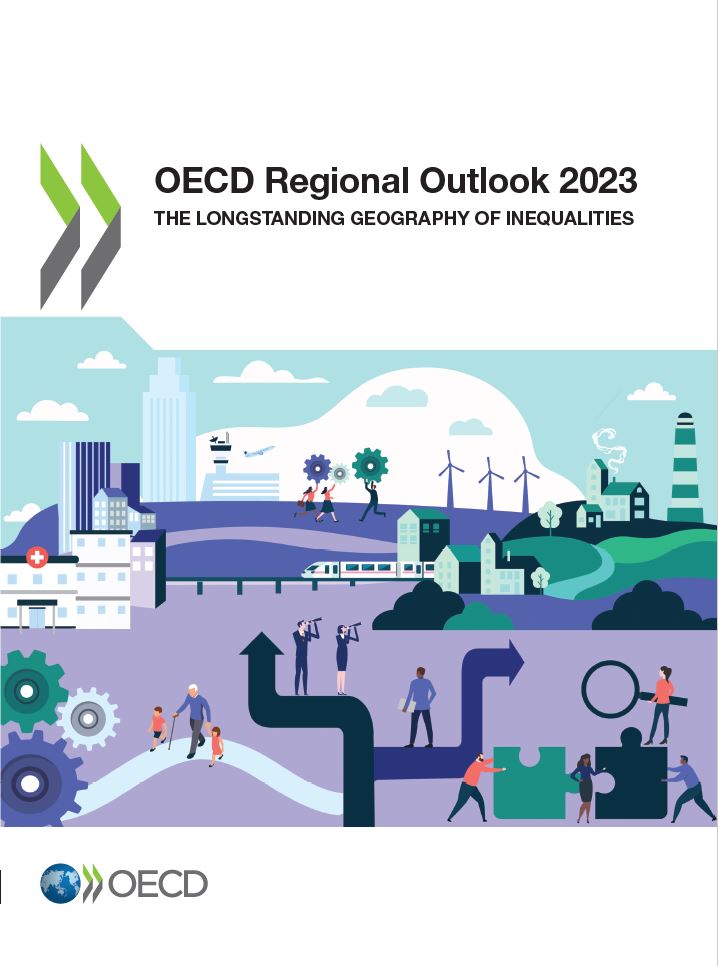Slovak Republic
| OECD Regional Outlook | |
|---|---|

|
The OECD Regional Outlook reviews recent trends, policy developments, and prospects across OECD regions, including the underlying causes driving regional inequalities in performance and well-being. The report offers evidence, guidance and policy recommendations on how to improve competitiveness and productivity, promote inclusive growth, accelerate the net-zero transition and raise well-being standards through effective regional development policy and multi-level governance. |
Regional inequality trends
The Slovak Republic experienced an increase in the Theil index of GDP per capita over 2000-2020. Inequality reached its maximum in 2009. The figures are normalized, with values in the year 2000 set to 1.
The Top 20%/Mean ratio was 0.074 higher in 2020 compared to 2000, indicating increased polarisation. The Bottom 20%/Mean ratio was 0.022 lower in the same period, indicating bottom divergence.
Note: Top/bottom calculated as population equivalent (top/bottom regions with at least 20% of the population). The interpretation of top/bottom 20% GDP per capita is that 20% of the population in the country holds 20% of the value. Top 20%/Mean calculated as mean GDP per capita in top 20% regions over mean TL3 GDP per capita in a given year. Bottom 20%/Mean calculated as mean TL3 GDP per capita in bottom 20% regions over mean TL3 GDP per capita in a given year. To improve data consistency, input series are aggregated when TL3 regions are part of the same FUA. To improve time series, TL3 missing values have been estimated based on the evolution at higher geographic level.
Source: OECD Regional Database (2022).
There is no data for the gap in GDP per capita between large metropolitan and non-large metropolitan regions for 2000 and 2020.
Meanwhile, in 2020, the gap in GDP per capita between metropolitan and non-metropolitan regions was 1.884. For reference, the same value for OECD was 1.325. This gap decreased by 0.016 percentage points since 2000.
In turn, the gap in GDP per capita between regions near and far a Functional Urban Area (FUA) of more than 250 thousand inhabitants was 1.813 in 2020 and increased by 0.067 percentage points since 2000.
Note: Far from a FUA>250K includes regions near/with a small FUA and remote regions. OECD mean gap based on 1 586 TL3 regions in 27 countries with available data (no TL3 data for Australia, Canada, Chile, Colombia, Costa Rica, Iceland, Ireland, Israel, Mexico, Luxembourg and Switzerland).
Source: OECD Regional Database (2022).
In the Slovak Republic, the gap between the upper and the lower half of regions in terms of labour productivity increased between 2001 and 2019. Over this period labour productivity in the upper half of regions grew roughly by 68%, 7 percentage points more than in the lower half of regions. During 2020, the gap continued to widen. Nevertheless, more years of data are necessary to determine the long-term impact of the COVID-19 pandemic on labour productivity gaps in regions.
Note: A region is in the “upper half” if labour productivity was above the country median in the first year with available data and “lower half” if productivity was below the country median. Labour productivity in each group is equal to the sum of Gross Value Added, expressed in USD at constant prices and PPP (base year 2015) within the group, divided by the sum of total employment in regions within the group. Regions are small (TL3) regions, except for Australia, Canada, Chile, Colombia, Ireland, Mexico, Norway, Switzerland, Türkiye and the United States where they are large (TL2) regions due to data availability.
Source: OECD Regional Database (2022).
Regions where the economic activity shifts towards tradable activities, such as industry and tradable services, tend to grow faster in terms of labour productivity. In the Slovak Republic, between 2001 and 2020, the share of workers in the industrial sector went down in all regions but more so in regions that used to be in the upper half of the labour productivity distribution. At the same time, the share of workers in the tradable services sector went up in all regions but more so in regions that were already in the upper half of the labour productivity distribution. Hence, the evolution of employment shares in the tradable services sector widened the labour productivity gap between regions while the opposite was true for the industrial sector.
Note: A region is in the “upper half” if labour productivity was above the country median in the first year with available data and “lower half” if productivity was below the country median. The share of workers in a given sector for a group of regions is defined as the sum of employment in that sector within the group divided by the sum of total employment within the group. Regions are small (TL3) regions, except for Australia, Canada, Chile, Ireland, Mexico, Norway, Switzerland, Türkiye and the United States where they are large (TL2) regions due to data availability. Industry includes the following tradable goods sectors: Mining and quarrying (B), Manufacturing (C), Electricity, gas, steam and air conditioning supply (D) and Water supply; sewerage; waste management and remediation activities (E) NACE macro sectors. Tradable services include Information and communication (J), Financial and insurance activities (K), Real estate activities (L), Professional, scientific and technical activities (M), Administrative and support service activities (N).
Source: OECD Regional Database (2022).
| Territorial definitions |
|---|
|
The data in this note reflect different sub-national geographic levels in OECD countries. In particular, regions are classified on two territorial levels reflecting the administrative organisation of countries: large regions (TL2) and small regions (TL3). Small regions are classified according to their access to metropolitan areas (Fadic et al. 2019). The typology classifies small (TL3) regions into metropolitan and non-metropolitan regions according to the following criteria:
Disclaimer: https://oecdcode.org/disclaimers/territories.html |